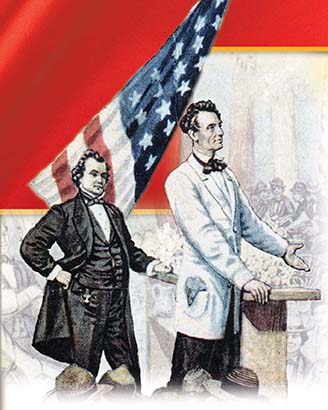SECTION 3: Political Realignment Deepens the Crisis

◄ Douglas and Lincoln debate
WITNESS HISTORY  AUDIO
AUDIO
A House Divided
In the election of 1858, Abraham Lincoln and Stephen A. Douglas competed to represent the state of Illinois in the U.S. Senate. In a series of debates that captured the nation’s attention, they argued about slavery. Douglas supported popular sovereignty as the way to resolve the slavery crisis. Lincoln, while not so certain of a solution, believed that the nation could not continue to exist half slave and half free. Lincoln kicked off his campaign with a speech summarizing his position:
“‘A house divided against itself cannot stand.’ I believe this government cannot endure permanently half slave and half free. I do not expect the Union to be dissolved—I do not expect the house to fall—but I do expect it will cease to be divided. It will become all one thing, or all the other.”
—Abraham Lincoln, June 16, 1858
Objectives
- Analyze how deepening sectional distrust affected the nation’s politics.
- Compare the positions of Abraham Lincoln and Stephen Douglas on the issue of slavery.
- Explain the effect of John Brown’s raid on the slavery debate.
Terms and People
- Know-Nothings
- Republican Party
- Dred Scott
- Roger B. Taney
- Abraham Lincoln
- Stephen A. Douglas
- Harpers Ferry
NoteTaking
Reading Skill: Sequence Use a timeline to record significant political events.

Early 1850s—Whig Party disintegrates
1850
1852
1854
1856
1858
Why It Matters Americans had always lived with sectional differences, but they temporarily resolved those differences through negotiation and compromise. By the mid-1850s, however, the battle over slavery threatened to tear the nation apart. Section Focus Question: What developments deepened the divisions between North and South?
The Shifting Political Scene
Traditionally, American political parties extended across sectional lines. Democrats and Whigs came from the North, South, and West. Presidents, too, had come from all areas of the country. But in the 1840s, American politics increasingly reflected regional tensions, especially over the issue of slavery.
The Whig Party Disintegrates
The Compromise of 1850, as well as the policies that grew out of it, caused political upheaval. Millard Fillmore—the last Whig President—angered the South with his support for California’s entry as a free state. Northerners inflamed by his support of the Fugitive Slave Act and popular sovereignty left the party in large numbers.




